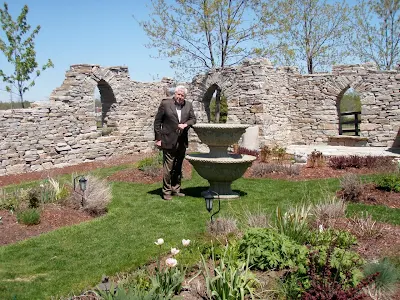
 Again talking about Sketchup - the second phase of the dry stone church ruins we built in Beaverton was completed in May of 2009. My helper Joe Mitchell and I spent a week and added the north wall to the nave, creating another full gothic window and two other openings in the wall, where it was supposed to look like there had been other windows. ( The thing about making 'ruins' is that you can decide it is 'finished' at any stage of the building of it! )
Again talking about Sketchup - the second phase of the dry stone church ruins we built in Beaverton was completed in May of 2009. My helper Joe Mitchell and I spent a week and added the north wall to the nave, creating another full gothic window and two other openings in the wall, where it was supposed to look like there had been other windows. ( The thing about making 'ruins' is that you can decide it is 'finished' at any stage of the building of it! ) My good friend Stephen Smith and I came back and revisited the project a month later to inspect it. I took this picture of him leaning on the concrete fountain. This was a fountain I never liked, by the way, and generally tried to not have it any of the photos I took of the ruins. (I can remove it in Sketchup by simply deleting it)
Some of the really interesting features in Sketchup are the many textures you can add to the objects in your drawing. It comes preloaded with this excellent stone pattern which I've applied to these walls. You can make your own stone textures to 'paint' on any Sketchup drawings of walls and buildings you've created by simply sampling photos of your own real stonework (you've created) and importing them into the program. The 'shadows' feature (which can be set in real time, to the month and day) is a clever application too and adds so much to a 3 D Sketchup file . Here I have programmed the shadows as they would have been on the day I took the photo of Stephen. It's interesting how closely they match.
You can imagine how satisfying a feeling it is to get the opportunity to do a realistic drawing of something this big and then actually build it and see it in real life, 'set in stone', so to speak. I think it is similar to how a composer might feel after hearing his symphony he wrote played for the first time by an entire orchestra. You should give it a try.
